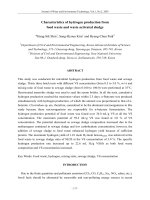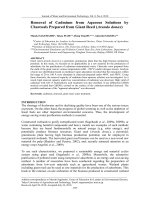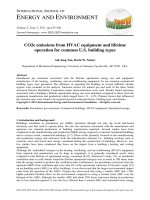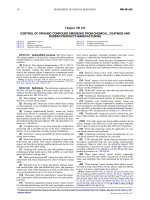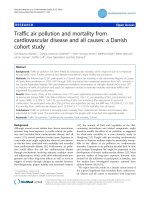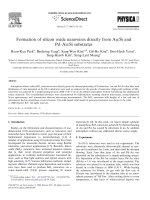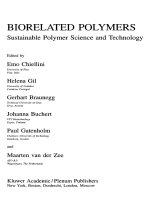- Trang chủ >>
- Khoa Học Tự Nhiên >>
- Vật lý
light scattering from polymer solutions and nanoparticle dispersions, 2007, p.200
Bạn đang xem bản rút gọn của tài liệu. Xem và tải ngay bản đầy đủ của tài liệu tại đây (3.33 MB, 200 trang )
Springer Laboratory
Springer Laboratory Manuals in Polymer Science
Schärtl, W.: Light Scattering from Polymer Solutions and Nanoparticle Dispersions
ISBN: 3-540-71950-4
Stribeck, N.: X-Ray Scattering of Soft Matter
ISBN: 3-540-46488-4
Koetz, J., Kosmella, S.: Polyelectrolytes and Nanoparticles
ISBN: 3-540-46381-X
Heinze, T., Liebert, T., Koschella, A.: Esterification of Polysaccharides
ISBN: 3-540-32103-9
Mächtle,W., Börger, L.: Analytical Ultracentrifugation of Polymers
and Nanoparticles
ISBN: 3-540-23432-2
Brummer, R.: Rheology Essentials of Cosmetics and Food Emulsions
ISBN: 3-540-25553-2
Hatada, Kitayama: NMR Spectroscopy of Polymers
ISBN: 3-540-40220-9
Kulicke, Clasen: Viscosimetry of Polymers and Polyelectrolytes
ISBN: 3-540-40760-X
Pasch, Schrepp: MALDI-TOF Mass Spectrometry of Synthetic Polymers
ISBN: 3-540-44259-6
Mori, Barth: Size Exclusion Chromatography
ISBN: 3-540-65635-9
Pasch, Trathnigg: HPLC of Polymers
ISBN: 3-540-61689-6 (hardcover)
ISBN: 3-540-65551-4 (softcover)
Wolfgang Schärtl
Light Scattering
from Polymer Solutions
and Nanoparticle
Dispersions
With 95 Figures and 16 Tables
123
Wolfgang Schärtl
Universität Mainz
Institut für Physikalische Chemie
Jakob-Welder-Weg 11
55099 Mainz
Germany
e-mail:
Library of Congress Control Number: 2007924911
DOI 10.1007/978-3-540-71951-9
ISBN 978-3-540-71950-2 Springer Berlin Heidelberg NewYork
e-ISBN 978-3-540-71951-9
This work is subject to copyright. All rights are reserved, whether the whole or part of the material is
concerned, specifically the rights of translation, reprinting, reuse of illustrations, recitation, broad-
casting, reproduction on microfilm or in any other way, and storage in data banks. Duplication o
f
this publication or parts there of is permitted only under the provisions of the German Copyright
Law of September 9, 1965, in its current version, and permissions for use must always be obtained
from Springer. Violations are liable for prosecution under the German Copyright Law.
Springer is a part of Springer Science+Business Media
springer.com
© Springer-Verlag Berlin Heidelberg 2007
The use of general descriptive names, registered names, trademarks, etc. in this publication does not
imply, even in the absence of a specific statement, that such names are exempt from the relevant pro-
tective laws and regulations and therefore free for general use.
Typesetting & Production: LE-T
E
X, Jelonek, Schmidt & Vöckler GbR, Leipzig, Germany
Coverdesign: WMXDesign GmbH, Heidelberg, Germany
SPIN 11530367 2/3180/YL – 5 4 3 2 1 0 Printed on acid-free paper
Springer Laboratory Manuals in Polymer Science
Editor
Priv Doz. Dr. Harald Pasch
Deutsches Kunststoff-Institut
Abt. Analytik
Schloßgartenstr.6
64289 Darmstadt Germany
e-mail:
Editorial Board
PD Dr. Ingo Alig
Deutsches Kunststoff-Institut
Abt. Physik
Schloßgartenstr.6
64289 Darmstadt Germany
email:
Prof. Josef Janca
Université de La Rochelle
Pole Sciences et Technologie
Avenue Michel Crépeau
17042 La Rochelle Cedex 01
France
email:
Prof. W M. Kulicke
Inst. f. Technische u. Makromol. Chemie
Universität Hamburg
Bundesstr. 45
20146 Hamburg
Germany
email:
To my parents Marga and Anton Schärtl
without whom, in many respects,
this book would not have been written.
Preface
Light scattering is a very powerful method to characterize the structure of poly-
mers and nanoparticles in solution. Recent technical developments have strongly
enhanced the possible applications of this technique, overcoming previous limi-
tations like sample turbidity or insufficient experimental time scales. However,
despite their importance, these new developments have not yet been presented in
a comprehensive form. In addition, and maybe even more important to the
broad audience, there is the lack of a simple-to-read textbook for students and
nonexperts interested in the basic principles and fundamental applications of
light scattering. As part of the Springer laboratory handbook series, this book
tries not only to provide such a simple-to-read and illustrative textbook about
the seemingly very complicated topic “light scattering from polymers and nano-
particles in dilute solution,” but also intends to cover some of the newest state-
ofthe-art technical developments in experimental light scattering.
It is a pleasure to acknowledge my sister Dr. Sabine Schärtl and several of my
colleagues at Mainz University who have read parts of this book and offered
criticism and helpful comments. I am especially indebted to Dr. Franziska Gröhn
and Dr. Karl Fischer as well as to Waltraut Mueller and Christian Scherer for
their careful study of the manuscript and their valuable suggestions. Last but not
least, I would like to thank Professor Manfred Schmidt for encouraging me to
write this book, and for the deeper insight into the light scattering method he
helped me gain during the last 10 years.
Mainz, Germany
November 2006 Wolfgang Schärtl
Table of Contents
1 FUNDAMENTAL CONCEPTS 1
1.1 Introduction 1
1.2 Static Light Scattering 3
1.3 Dynamic Light Scattering 16
2 EXPERIMENTAL SETUPS 25
2.1 Single Angle Scattering Using Goniometer Setups 26
2.2 Simultaneous Multiangle Scattering 29
2.3 Fiber-Optic Quasielastic Light Scattering 33
2.4 Crosscorrelation Techniques – Dual Color and 3D Dynamic
Light Scattering 34
References 37
3 COMMERCIAL LIGHT SCATTERING INSTRUMENTS 39
3.1 Single-Angle Light Scattering 40
3.2 Multiangle Light Scattering (MALS) 41
3.3 Fiber Optic Quasielastic Light Scattering
and 3D Crosscorrelation 42
4 SAMPLE PREPARATION 43
4.1 Sample Concentration and Interparticle Interactions 44
4.2 Sample Purification 49
References 50
5 SELECTED EXAMPLES OF LIGHT SCATTERING EXPERIMENTS 51
5.1 Dynamic Light Scattering 54
5.2 Static Light Scattering 95
5.3 New Light Scattering Methods 148
References 173
XII Table of Contents
6 SAMPLE CELLS, FILTERS AND SOLVENTS 177
6.1 Sample Cells 177
6.2 Disposable Syringe Membrane Filters 178
6.3 Characteristics of Common Solvents 180
References 182
7 FURTHER READING 183
INDEX 189
Glossary of Important Symbols and Abbreviations
2
A second Virial coefficient
2
b
, K single particle scattering power or contrast factor
CUM Cumulant data analysis of dynamic light scattering data
app
D apparent selfdiffusion coefficient
f
d fractal dimension
DLS dynamic light scattering
D
dn dc
refractive index increment
R
D
rotational selfdiffusion coefficient
D
s
selfdiffusion coefficient (translation)
s
z
D
z-average selfdiffusion coefficient
T
D
translational selfdiffusion coefficient
E electric field strength
c
f
coherence factor
FFF field flow fractionation
FOQELS fiber optic quasielastic light scattering
()
τ
,
s
Fq
,
()
τ
1
,
g
q
amplitude correlation function or dynamic structure factor
()
τ
2
,
g
q
intensity autocorrelation function
GPC gel permeation chromatography
()
τ
,
s
Gr
van Hove selfcorrelation function
s
I
scattered intensity
k
L
Kuhn length
m electric dipole momentum
MALLS or MALS multiangle laser light scattering
MSCS multispeckle correlation spectroscopy
M
w
weight average molar mass
n
D
index of refraction
()
Pq
particle form factor
q magnitude of scattering vector
R absolute scattered intensity or Rayleigh ratio
R
g
, s radius of gyration
2
g
z
R
z-average squared radius of gyration
R
H
hydrodynamic radius
−1
H
z
R
inverse z-average hydrodynamic radius
SLS static light scattering
α
polarizability
XIV Glossary of Important Symbols and Abbreviations
Γ
decay rate (of correlation function)
Γ
0
,
κ
1
first Cumulant ( =⋅
2
s
Dq)
Γ
1
,
κ
2
second Cumulant
()
Δτ
2
R mean-square particle displacement
η
solvent viscosity
θ
scattering angle
λ
wavelength of incident (and scattered) light
ρ
ρ -ratio (
=
g
H
RR
)
σ
R
particle size polydispersity
τ
correlation time
1 Fundamental Concepts
1.1 Introduction
All matter consists of atoms, which themselves are built from negative and posi-
tive charges. To describe the interaction of light with matter, one has to consider
that light has both particular and wave character. Treating light within the clas-
sical wave picture, it is fairly simple to understand the origin of the phenome-
non of light scattering: as an electromagnetic wave (a periodic modulation of
electric and magnetic field strength both in space and time (see Eq. 1.1) for the
electric field strength of a linearly polarized light beam of wavelength
λ
, propa-
gating in x-direction), light will interact with the charges constituting a given
molecule in remodelling the spatial charge distribution.
()
⎛⎞
⎛⎞
⎜⎟
⎜⎟
⎛⎞
=+
⎜⎟
⎜⎟
⎜⎟
⎝⎠
⎜⎟
⎜⎟
⎜⎟
⎝⎠
⎝⎠
π
π
λ
λ
0
2
2
,sin sin
c
x
Ext E
t
(1.1)
The magnitude of this effect is given by a certain physical quantity: the po-
larizability of the molecule, that is, the ease of shifting charges within the mole-
cule. The charge distribution follows the time-modulation of the electric wave
vector of the incident light beam, and therefore the molecule constitutes an
oscillating dipole or electric oscillator. This oscillating dipole acts as an emitter
of an electromagnetic wave of the same wavelength as the incident one (for this
reason, the process is called “elastic scattering”), emitted isotropically in all
directions perpendicular to the oscillator as illustrated in Fig. 1.1.
The angle of observation with respect to the direction of the incident light
beam is called the scattering angle and provides, as we will see further below,
a measure for the length scale observed in a light scattering experiment.
For molecules or particles larger than 20 nm, several of these oscillating di-
poles are created simultaneously within one given particle. As a consequence,
some of the emitted light waves possess a significant phase difference. Accord-
ingly, interference of the scattered light emitted from such an individual parti-
cle of size larger than 20 nm leads to a nonisotropic angular dependence of the
scattered light intensity. The interference pattern of intraparticular scattered
light, also called particle form factor, is characteristic for size and shape of the
2 1 Fundamental Concepts
scattering particle. As a consequence, it provides the quantitative means for the
characterization of particles in very dilute solution by light scattering. For par-
ticles smaller than
λ
/20, only a negligible phase difference exists between light
emitted from the various scattering centers within the given particle. In this
case, the detected scattered intensity will be independent of the scattering angle
and only depend on the mass of the particle which is proportional to the total
number of scattering centers one particle contains. The difference in the inter-
ference pattern of light scattered by very small and by larger particles, leading
to a characteristic angular dependence of the measured scattered intensity for
the latter, is illustrated in Fig. 1.2.
So far, we have considered light scattering as a purely elastic process where
the emitted light has exactly the same wavelength as the incident light. Particles
in solution, however, usually show a random motion (Brownian motion) caused
by thermal density fluctuations of the solvent. As a consequence of the temporal
changes in interparticle positions and the corresponding temporal concentration
fluctuations, the interference pattern and the resulting scattered intensity de-
tected at a given scattering angle also change with time, reflecting the Brownian
motion of the scattering particles, as illustrated in Fig. 1.3.
Fig. 1.1. Oscillating dipole induced by an incident light wave, and accordingly emitted
light.
Fig. 1.2. Interference pattern of light scattered from small particles (left) and from larger
particles (right). For simplification, only two scattering centers are shown.
1.2 Static Light Scattering 3
This phenomenon provides the basis for dynamic light scattering, an experi-
mental procedure which yields a quantitative measure for the mobility of scatter-
ing particles in solution as characterized by their selfdiffusion coefficient. Most
modern particle sizers, frequently used both in industry and academia nowadays
to determine the (hydrodynamic) size of particles in solution, are based on this
principle.
In the following two chapters, the theoretical background of the two funda-
mental light scattering methods, that is static and dynamic light scattering, will
be presented in more detail. A few mathematical relations which are most essen-
tial for the practice of light scattering will be highlighted in grey boxes to stress
their importance.
1.2 Static Light Scattering
As mentioned above, matter scatters electromagnetic waves (light) due to the
induction of an oscillating electric dipole, which serves as a source for the scat-
tered light wave. The electric dipole momentum
m
depends on polarizability
α
and electric field vector
E
of the incident radiation as:
()
()
== −
απν
0
,exp2mE EE i tkx (1.2)
=
ν
λ
c
is the frequency of light of wavelength
λ
, and ==
πλ
2kk the length of
the wave vector. In Eq. 1.2 I have assumed linearly and, in respect to the scatter-
ing plane (see below), vertically polarized light propagating into x-direction. The
Fig. 1.3. Sketch of the change in the interference pattern of scattered intensity with time,
caused by Brownian motion of two scattering particles.
4 1 Fundamental Concepts
electric field vector of the scattered light wave emitted by the oscillating dipole is
given as:
()
()
−
∂
⎛⎞
== −
⎜⎟
∂
⎝⎠
πνα
πν
22
2
0
22 2
4
1
exp 2
D
s
DD
E
m
Eitkr
trc rc
(1.3)
Here,
D
r is the distance vector from the scattering sample to the detector. In
a light scattering experiment not the electric wave vector amplitude, but the
scattered intensity
∗
==
2
sss s
IEE E is detected. The principle setup for any static
light scattering experiment, defining the important quantities, is illustrated in
Fig. 1.4.
I
0
is the intensity of the incident light beam, I
s
the intensity of the scattered
light,
θ
the scattering angle and
D
r the distance between sample and detector.
The polarizability
α
depends on the dielectric permittivity ε (and correspond-
ingly on the index of refraction n
D
) as:
=−= −
παε
2
411
D
N
n
V
(1.4)
with N the number of scattering particles within the scattering volume V. The
scattering volume is defined by the intersection of incident light beam and opti-
cal aperture used for observing the scattered light intensity, and therefore de-
pends on the scattering angle as shown in Fig. 1.5.
Fig. 1.4. Sketch of the light scattering process, including detection of the scattered in-
tensity at scattering angle
θ
.
Fig. 1.5. Dependence of the scattering volume on the scattering angle.
1.2 Static Light Scattering 5
As a consequence, in a light scattering experiment the detected scattered in-
tensity has to be normalized to a constant, scattering-angle-independent, scat-
tering volume by factorization with
θ
sin .
Importantly, the polarization direction of the incident laser beam with re-
spect to the scattering plane may cause an additional dependence of the detected
scattered intensity on scattering angle: horizontally polarized light (h), for ex-
ample, leads to a factor of
⋅
θ
2
2cos for the scattered intensity. In case of unpo-
larized light (u), the polarization factor assumes a value of
+
θ
2
1cos . The origin
of this effect is that the intensity of the electromagnetic wave emitted by an os-
cillating dipole is strongest perpendicular to the axis of its oscillations, which in
case of horizontally polarized light corresponds to a scattering angle
=°
θ
0 . For
simplification and if not stated otherwise, I will restrict myself in the following
to vertical polarization (v) of the incident laser beam. In this case the polariza-
tion factor assumes a constant value of 2, and therefore the scattered intensity
per constant scattering volume is independent of the scattering angle for very
small particles of size <10 nm. The three different polarization factors for v, h,
and u polarization of the incident laser light are illustrated in Fig. 1.6.
This sketch is valid for the absence of depolarization effects, as for example
caused by rotation of optically anisotropic scattering molecules (see Chap. 5), in
which case the polarization of the scattered light is identical to that of the inci-
dent light. Obviously, the maximum scattered intensity over the whole range of
scattering angles is given for vertical polarization of the incident light, which is
the reason why this scattering geometry is preferred in the experimental practice
of light scattering.
1.2.1 Scattering from Dilute Solutions of Very Small Particles
For very dilute solutions of small scattering particles (for example nanoparticles
or polymer chains of size smaller than
λ
/20, see above), the scattering intensity
is independent of the scattering angle and, in case scattering from the density
Fig. 1.6. Angular dependence for the
polarization factors of light scattered
from a solution of very small mole-
cules, as detected in the scattering
plane for different polarizations o
f
the incident light wave (horizontal
polarization (2
2
cos
θ
, dotted line),
nonpolarized light (
2
1cos
θ
+ , dashe
d
line) and vertical polarization (2,
s
oli
d
line). The grey bar is the incident light
beam, the grey circle in the center the
scattering volume.
6 1 Fundamental Concepts
fluctuations of the solvent itself is ignored, only depends on the scattering power
of the dissolved particles b, their mass concentration c and the osmotic pressure
π
:
∂
∂
∼
π
2
,
()
TN
c
IbkT
c
(1.5)
The interested reader should note that Eq. 1.5 has been derived from fluctua-
tion theory, using
⎛⎞ ⎛⎞
=
⎜⎟ ⎜⎟
⎝⎠ ⎝⎠
μ
π
ρ
0
0
M
dd
dc dc
(with
μ
the chemical potential of the solvent
in the solution, M
0
the molar mass of the solvent molecules and
ρ
0
the solvent den-
sity).
According to van´t Hoff:
∂
=
∂
π
kT
cM
(ideal solutions) (1.6a)
∂
=++
∂
π
2
1
2
()kT A c
cM
(real solutions) (1.6b)
with M the molar mass of the dissolved particles and A
2
the second Virial coeffi-
cient which provides a quantitative measure for the solvent-solute-interactions.
Here, “ideal solution” means the absence of specific interactions between sol-
vent and solute molecules (
=
2
0A ).
The scattering power b
2
(see Eq. 1.5) depends on the difference in polarizabil-
ity of solute and solvent (Δ
α
), which itself depends on the respective refractive
indices as:
−−
−
=− = = =
εε
Δα α α
π
ππ
2222
,0 ,0
0
0
4
44
DD DD
nn nn
NN
n
VV
(1.7)
n
D
is the refractive index of the solute, n
D,0
the refractive index of the solvent and
n the particle number density.
Using the refractive index increment
−
∂
∂
,0
()
DD
D
nn
n
cc
(1.8)
the scattering power of one individual solute particle (
2
b ), also called contrast
factor K, can be expressed as:
∂
==
∂
π
λ
2
222
,0
4
0
4
()
D
D
L
n
bn K
Nc
in cm
2
g
−
2
Mol (1.9)
Importantly, the scattered intensity scales inversely with the wavelength of
the incident light to the power of four. Rayleigh scattering from the small gas
molecules of our atmosphere is the reason that the sky looks blue: the short
wavelength blue part of the spectrum of the incident sun light is scattered more
strongly than the longer wavelength red part.
1.2 Static Light Scattering 7
It should be noted that the scattered intensity given in Eq. 1.5 still depends
on the actual experimental setup (for example on the sample-detector distance).
This leads us to the so-called Rayleigh ratio R, which is an absolute scattering
intensity not depending on the experimental conditions such as scattering vol-
ume V or the sample-detector distance r
D
:
∂
=⋅ = = −
∂
π
λ
2
2
222
,0
4
0
4
()
()
DD
D solution solvent
LL
nr
cM cM
Rb n I I
NcN V
(1.10)
In practice, the absolute scattered intensity R of the solute particles is deter-
mined from the experimentally measured scattered intensities of the solution
solution
I and of the solvent
solvent
I as well as the intensity measured for a scattering
standard
std
I (typically the pure solvent toluene), renormalized by the so-called
absolute scattering intensity of the standard
,std abs
I
:
()
=−⋅
,std abs
solution solvent
std
I
RI I
I
(1.11)
Note that in this case all scattered intensities have to be measured using the
same experimental setup.
,std abs
I
, the absolute scattering intensity of the standard
(measured in [cm
−
1
]), can be found in reference tables (see also Chap 6 of this
book).
Importantly, the reader should keep in mind that for comparatively small
particles of size <10 nm, in which case intraparticular interference of the scat-
tered light becomes negligible, the absolute scattered intensity of a given sample
detected at any scattering angle is constant and only depends on the optical
contrast
2
b
and the number of particles within the scattering volume (= number
density
=nNV) times the mass of a single scattering particle squared,
=⋅ =⋅⋅
2222
LL
RbcMN bnMN. This is simple to understand since the number of
individual scattering centers of a single scattering particle is given by the molar
mass of the particle. Therefore, the scattered intensity has to be proportional to
the particle mass squared. This point has been stressed here because it is needed
to determine which type of average sample characteristics is obtained by light
scattering from polydisperse samples containing small particles, like for exam-
ple synthetic polymer chains: the most important of these average sample char-
acteristics determined in a static light scattering measurement are the z-average
radius of gyration and the weight-average molar mass, as will be explained in
detail further below.
Finally, for nonideal solutions (see Eq. 1.6b above), Eq. 1.10 can be rewritten
to yield the basic equation for static light scattering experiments on solutions of
small (size <10 nm) particles:
=+ +
2
1
2
Kc
Ac
RM
(1.12)
8 1 Fundamental Concepts
1.2.2 Scattering from Dilute Solutions of Larger Particles
For larger scattering particles, the scattered intensity is no longer independent
of the scattering angle. The so-called scattering vector
q
(in [cm
−
1
]),
which is
experimentally determined by the scattering angle
θ
and the wavelength of the
laser light
λ
. provides a quantitative measure for the length scale of the static
light scattering experiment. Figure 1.7 shows how the value of
q
is derived from
a given scattering geometry:
Fig. 1.7. Sketch of the
definition of the scattering
vector
0
q
kk
=−
.
0
k and
k are the wave vectors of the incident and of the scattered light
beam;
θ
is the scattering angle. The scattering vector
q is simply the difference
of the two wave vectors, i.
e., =−
0
qkk. For an elastic scattering process,
==
π
λ
0
2
kk
, and therefore:
==
θ
π
λ
4sin( )
2
(1.13)
In addition, the refractive index of the solvent itself
D
n has to be taken into
account since it changes the wavelength of the incident light compared to its
value in air (
=1
D
n ):
=
θ
π
λ
4sin()
2
D
n
q
(1.14)
For very dilute solutions, interferences between different scattering particles,
the so-called structure factor, can be neglected. In this case, the angular depend-
ence of the measured scattered intensity I(q) is only caused by intraparticular
interferences, leading us by pair-wise summation over all scattering centers of
a single particle to:
()
== ==
⎡⎤
⎡
⎤
=−−=−
⎣
⎦
⎣⎦
∑∑ ∑∑
22 22
11 11
() exp exp
ZZ ZZ
ij ij
ij ij
Iq Nb iqr r Nb iqr
(1.15)
Here, our sample consists of N identical particles within the scattering vol-
ume, each particle containing Z scattering centers. i, j stand for two of these
scattering centers within the same particle, and
ij
r are the distance vectors be-
tween them defining the particle density distribution, accordingly.
1.2 Static Light Scattering 9
Radius of Gyration/Molar Mass/Zimm Equation
For isotropic particles the normalized single particle scattering, also called parti-
cle form factor ()Pq, after series expansion is given as:
()
()
()
== ==
== −=−+
∑∑ ∑∑
22
22
222
11 11
1
111
( ) exp 1
6
ZZ ZZ
ij
ij
ij ij
Pq I q iqr qr
ZZ
NZb
(1.16)
For simplification, I will introduce here the so-called center of mass coordi-
nate system: the origin of the Cartesian coordinate system is transferred to the
particle’s center of mass, as shown in Fig. 1.8.
Note that Cartesian position vectors
i
r accordingly have to be replaced by
the center of mass-based position vectors (
i
s ). If we assume a homogeneous
particle with constant particle density
()
=
ρρ
i
s , we find:
=
=
∑
1
0
Z
i
i
s and
=
=≠
∑
2
2
1
1
0
Z
i
i
ss
Z
(1.17)
2
s is the squared radius of gyration of the scattering particle, usually denoted
as
2
g
R . Inserting the distance vector
=−
ij j i
rss
, we can rewrite the summation
expression contained in the particle form factor (Eq. 1.16):
== ==
=+−=
∑∑ ∑∑
2
22 2
22
11 11
11
(2())2
ij
ZZ ZZ
ij
ij
ij ij
rsssss
ZZ
(1.18)
where we have used that
==
∑
∑
11
ij
ZZ
ij
ss = 0 if ≠ij. Therefore, we finally get for the
particle form factor:
=− +
22
1
( ) 1
3
Pq sq
(1.19)
Fig. 1.8. Definition of the center-of-
mass and the corresponding center-
of-mass coordinates of a scattering
particle.
10 1 Fundamental Concepts
To take into account the effects of particle concentration and solute-solvent
interactions on the measured scattering intensity, we have to refer to thermody-
namic fluctuation theory. In conclusion, it can be shown that the normalized
absolute scattering intensity R depends on the particle form factor as:
=++
2
1
2
()
Kc
Ac
RMPq
(1.20)
Inserting
()
Pq from Eq. 1.19 into Eq. 1.20, we derive the very important Zimm
equation:
=+ +
22
2
11
12
3
()
Kc
sq Ac
RM
(1.21)
This equation provides the basis for analyzing the scattered intensity from
comparatively small particles (s
2
q
2
<<1, in case of light scattering: 10 nm < par-
ticle radius <50 nm) to determine the molar mass, the radius of gyration
12
2
s
and the second Virial coefficient A
2
, the latter providing a quantitative measure
for the solute particle-solvent interactions. Here, stands for the isotropic
particle ensemble average, which is an orientational average in case of rod-like
scattering particles, or a chain conformation average in case of random polymer
coils. The reader should note that in a static light scattering experiment, even in
case of very dilute sample solutions, an extremely large number of particles are
located in the scattering volume (>10e9). Therefore, the measured particle form
factor corresponds to an orientational average for anisotropic particles, which
are randomly oriented within the sample. For linear polymer chains of identical
chain length, on the other hand, each random polymer coil may assume a differ-
ent conformation. In this case, the measured particle form factor corresponds to
a conformational ensemble average. In addition, the orientation and/or confor-
mation of a given scattering particle is changing with time.
So far, we have only considered so-called monodisperse particle solutions,
that is, solutions which contain solute particles all identical in size and shape.
For polydisperse samples, the Zimm analysis of the light scattering data accord-
ing to Eq. 1.21 yields the following averages:
(i) The weight average of the molar mass
=
=
=
∑
∑
1
1
K
kkk
k
K
w
kk
k
NMM
M
NM
(1.22)
(ii) The z-average of the squared radius of gyration:
=
=
<>= =
∑
∑
22
22
1
2
1
K
kkk
k
K
zg
z
kk
k
NM s
sR
NM
(1.23)
1.2 Static Light Scattering 11
Here, our sample consists of K particle species of different molar mass and
different size but identical chemical composition, and
k
N is the number of scat-
tering particles of species
k
[each with identical molecular mass
k
M
and identi-
cal squared radius of gyration (
2
k
s )] within the scattering volume. It is straight
forward to understand the origin of these averages keeping in mind what
I described in some detail above: in the small particle regime considered here, the
scattered intensity of a given particle species k depends on its optical contrast,
which is identical for all particles irrespective of their molar mass, and on num-
ber and molar mass as
2
kk
NM . Therefore, sample characteristics measured in
a light scattering experiment and depending directly on the scattered intensity
correspond to so-called z-averages (see Eq. 1.23), where the number distribution
function (
k
N ) of the respective quantity has to be weighted with
2
k
M
. On the
other hand, the reduced scattered intensity Kc R (see Eq. 1.21) is determined
from the ratio of sample mass concentration and measured scattered intensity,
reducing the average of the molar mass to a weight average
w
M
, where the mass
distribution
kk
NM of the polydisperse sample is only weighted with
k
M
.
Particle Form Factor for “Large” Particles
Without series expansion (see Eq. 1.16), which is only valid for light scattering
from small particles, the particle scattering form factor is given as:
==
=−
∑∑
2
11
1
() exp( )
ZZ
ij
ij
Pq iqr
Z
(1.24)
For homogeneous spherical particles, one gets:
()
() ()
()
=−
2
6
9
() sin cos
P q qR qR qR
qR
(1.25)
with
R the radius of the sphere.This expression (Eq. 1.25) corresponds to an
oscillating function, as shown in Fig. 1.9.
The position of the first minimum is found at qR = 4.49, which can be used to
easily determine the particle radius R. Note that the oscillations are not as well pro-
nounced for scattering from polydisperse spherical particles, as shown in Fig. 1.10.
For some other simple particle morphologies, the following particle form fac-
tors are obtained. Importantly, all form factors of anisotropic particles given
here, like the form factors of thin disks or rigid rods, are orientational ensemble
averages, as has been discussed above.
1. Hollow sphere of radius
R with very thin shell:
()
⎡
⎤
=
⎢
⎥
⎣
⎦
2
sin
()
qR
Pq
qR
(1.26)
12 1 Fundamental Concepts
Fig. 1.10. Particle form factor for polydisperse spheres.
2. Thin disk of radius R:
()
()
⎡
⎤
=−
⎢
⎥
⎣
⎦
2
1
21
() 1 2Pq J qR
qR
qR
(1.27)
with J
1
being the so-called first-order Bessel function.
Fig. 1.9. Particle form factor for monodisperse spheres.
1.2 Static Light Scattering 13
3. Thin cylinder of length L:
() ()
⎛⎞
⎜⎟
⎝⎠
=−
⎛⎞
⎜⎟
⎝⎠
2
2
sin
2
2
2
qL
Pq SiqL
qL
qL
(1.28)
with
(
)
0
sin
x
u
Si x du
u
=
∫
the so-called sinus-integral-function.
Next, I will briefly discuss an alternative approach towards determining the
topology of solute particles from the angular dependence of the scattered inten-
sity, besides fitting the experimental data to an assumed particle form factor
according to Eqs. 1.26–1.28. This second method is based on the so-called fractal
dimension, which is the scaling of particle mass with particle size.
Radius of Gyration and Geometrical Radius for Particles of Various
Morphologies in Dependence of Molar Mass
In general, the radius of gyration is given as a volume integral over the mass
distribution of a given particle, that is:
=
∫
∫
2
2
()
()
i
i
V
i
V
mr rdV
s
mr dV
(1.29)
In the following, solutions of this equation for some selected particle mor-
phologies will be presented:
1. For a homogeneous sphere of radius
R and mass density
ρ
:
==
∫
∫
ρπ
ρπ
22
22
0
2
0
4
3
5
4
R
R
rrdr
sR
rdr
(1.30)
For the molar mass, one gets:
∼∼
2
22
3
M
sR (1.31)
2. For a hollow sphere of radius
R and very thin shell
s
d :
⋅
==
⋅
ρπ
ρπ
22
22
2
4
4
s
s
RdR
sR
Rd
(1.32)
and
∼∼
22
M
sR
(1.33)
